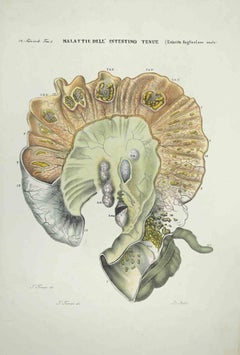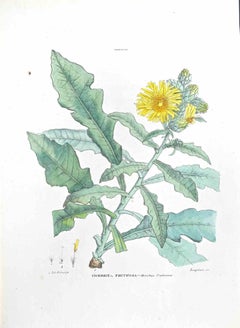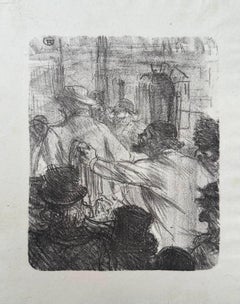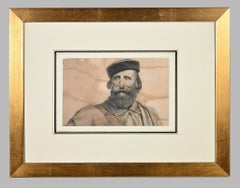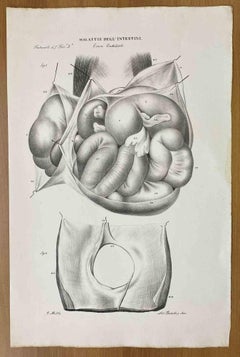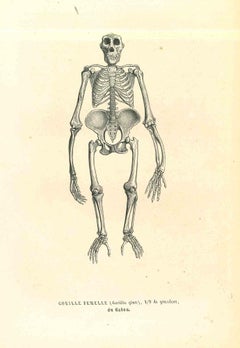19th Century Figurative Prints
to
346
6,303
1,006
181
50
40
Overall Width
to
Overall Height
to
5,405
354
123
55
34
25
16
7
2
269
123
115
112
102
3,530
7,596
25,431
6,816
292
597
1,410
1,236
1,326
2,299
3,258
5,190
2,840
1,348
3,028
4,463
3,074
41
5,242
2,673
2,074
1,785
1,525
1,056
862
574
547
509
507
502
433
291
243
239
228
220
208
197
4,333
2,106
682
675
445
325
5,652
4,093
763
Period: 19th Century
Diseases of the Small Intestine - Lithograph By Ottavio Muzzi - 1843
Located in Roma, IT
Diseases of the Small Intestine is a lithograph hand colored by Ottavio Muzzi for the edition of Antoine Chazal, Human Anatomy, Printers Batelli and Ridolfi, 1843.
The work belongs ...
Category
Modern 19th Century Figurative Prints
Materials
Lithograph
The Cicerbita Fruticosa - Lithograph by Vincenzo Tenore - 1870s
Located in Roma, IT
Lithograph hand watercolored.
Plate from "Atlante di Botanica popolare ossia Illustrazione di Piante Notevoli di ogni famiglia" (Atlas of popular botany or illustration of notable p...
Category
Modern 19th Century Figurative Prints
Materials
Lithograph
Henri de Toulouse-Lautrec, La halle aux draps, Cracovie, 1898
Located in Torino, IT
HENRI DE TOULOUSE LAUTREC, Albi 1864 - Malromé 1901
La halle aux draps, Cracovie, 1898
Original lithograph on stone monogrammed in plate (mm 176x144) Bibliography: Wittrock 197
Fro...
Category
Impressionist 19th Century Figurative Prints
Materials
Lithograph
Giuseppe Garibaldi - Lithograph - Late 19th Century
Located in Roma, IT
Portrait of Garibaldi is an original Modern Artwork realized in the Second Half of the 19th Century by an Anonymous artist.
Lithograph on paper.
Browing of paper due to the time a...
Category
Modern 19th Century Figurative Prints
Materials
Lithograph
Intestinal Diseases - Lithograph By Ottavio Muzzi - 1843
Located in Roma, IT
Intestinal Diseases is a lithograph hand colored by Ottavio Muzzi for the edition of Antoine Chazal, Human Anatomy, Printers Batelli and Ridolfi, 1843.
The work belongs to the Atla...
Category
Modern 19th Century Figurative Prints
Materials
Lithograph
The Skeleton - Lithograph by Paul Gervais - 1854
By Paul Gervais
Located in Roma, IT
The Skeleton is an original lithograph on ivory-colored paper, realized by Paul Gervais (1816-1879). The artwork is from The Series of "Les Trois Règnes de la Nature", and was publis...
Category
Modern 19th Century Figurative Prints
Materials
Lithograph, Paper
Pendant l'Entracte - Original Lithograph by Alexandre Lunois - 1894
Located in Roma, IT
Pendant l'entracte is a beautiful and colored lithograph on paper, signed in pencil on lower left margin by Alexandre Lunois (1863 -1916).
This original print, representing a couple...
Category
Modern 19th Century Figurative Prints
Materials
Lithograph
The Rage and Agony - Original Lithograph by Paul Gavarni - 1881
By Paul Gavarni
Located in Roma, IT
The rage and agony is an original lithograph artwork on ivory-colored paper, realized by the French draftsman Paul Gavarni (after) (alias Guillaume Sulpice Chevalier Gavarni, 1804-18...
Category
Modern 19th Century Figurative Prints
Materials
Paper, Lithograph
Gerlach's Allegorien Folio, plate #53: "Junius" Lithograph, Gustav Klimt.
By Gustav Klimt
Located in Chicago, IL
Contributors to Gerlach & Schenk’s publications valued design and innovation in the graphic arts just as much as they examined allegories as subject matter for exploration. Here, Gus...
Category
Vienna Secession 19th Century Figurative Prints
Materials
Lithograph
The Companionship - Original Lithograph by Paul Gavarni - 1881
By Paul Gavarni
Located in Roma, IT
The companionship is an original lithograph on ivory-colored paper, realized by the French draftsman Paul Gavarni (after) (alias Guillaume Sulpice Chevalier Gavarni, 1804-1866) in Pa...
Category
Modern 19th Century Figurative Prints
Materials
Paper, Lithograph
The Common Medlar - Lithograph by Vincenzo Tenore - 1870s
Located in Roma, IT
Lithograph hand watercolored.
Plate from "Atlante di Botanica popolare ossia Illustrazione di Piante Notevoli di ogni famiglia" (Atlas of popular botany or illustration of notable p...
Category
Modern 19th Century Figurative Prints
Materials
Lithograph
Man from Puebla - Original Lithograph - 1849
Located in Roma, IT
Man from Puebla is an original hand-watercolored lithograph on ivory paper by Anonymous Artist of 19th Century, in 1849.
In excellent conditions: As good as new.
Not signed. Title...
Category
Modern 19th Century Figurative Prints
Materials
Paper, Lithograph
Diseases of the Ovary - Lithograph By Ottavio Muzzi - 1843
Located in Roma, IT
Diseases of the Ovary is a lithograph hand colored by Ottavio Muzzi for the edition of Antoine Chazal, Human Anatomy, Printers Batelli and Ridolfi, 1843.
The work belongs to the Atl...
Category
Modern 19th Century Figurative Prints
Materials
Lithograph
The Santalee - Lithograph by Vincenzo Tenore - 1870s
Located in Roma, IT
Lithograph hand watercolored.
Plate from "Atlante di Botanica popolare ossia Illustrazione di Piante Notevoli di ogni famiglia" (Atlas of popular botany or illustration of notable p...
Category
Modern 19th Century Figurative Prints
Materials
Lithograph
Gentle Fondness - Original Lithograph by Paul Gavarni - 1881
By Paul Gavarni
Located in Roma, IT
Gentle Fondness is an original lithograph artwork on ivory-colored paper, realized by the French draftsman Paul Gavarni (after) (alias Guillaume Sulpice Chevalier Gavarni, 1804-1866)...
Category
Modern 19th Century Figurative Prints
Materials
Lithograph
Gerlach's Allegorien Plate #47: "Morning in the Spring" Lithograph
Located in Chicago, IL
Koloman Moser
(1868 –1918), AUSTRIAN
Instead of applying his flair and art education solely to painting, Koloman Moser embodied the idea of Gesamt Kunstwerk (all-embracing art work) by designing architecture, furniture, jewelry, graphics, and tapestries meant to coordinate every detail of an environment. His work transcended the imitative decorative arts of earlier eras and helped to define Modernism for generations to come. Moser achieved a remarkable balance between intellectual structure (often geometric) and hedonistic luxury.
Collaborating with Gustav Klimt and Josef Hoffmann, the artist was an editor and active contributor to Ver Sacrum, (Sacred Spring), the journal of the Viennese Secession that was so prized for its aesthetics and high quality production that it was considered a work of art. The magazine featured drawings and designs in the Jugendstil style (Youth) along with literary contributions from distinguished writers from across Europe. It quickly disseminated both the spirit and the style of the Secession.
In 1903 Moser and Hoffmann founded and led the Wiener Werkstatte (Viennese Workshop) a collective of artisans that produced elegant decorative arts items, not as industrial prototypes but for the purpose of sale to the public. The plan, as idealistic then as now, was to elevate the lives of consumers by means of beautiful and useful interior surroundings.
Moser’s influence has endured throughout the century. His design sensibility is evident from the mid-century modern furniture of the 1950s and ‘60s to the psychedelic rock posters...
Category
Vienna Secession 19th Century Figurative Prints
Materials
Paper
Wigeon- Woodcut Print by Alexander Francis Lydon - 1870
Located in Roma, IT
Wigeon is a modern artwork realized in 1870 by the British artist Alexander Francis Lydon (1836-1917).
Woodcut print on ivory-colored paper.
Hand-colored, published by London, Bell...
Category
Modern 19th Century Figurative Prints
Materials
Woodcut
Fountain with Castle - Original Etching hand Watercolored by A. Wolf - 1890s
Located in Roma, IT
Fountain with Castle is an excellent Modern artwork realized by the German artist Augusto Wolf (Weinheim, 1842 - Venice, 1915) in the 1890s.
Original Watercolored Etching.
Hand-s...
Category
19th Century Figurative Prints
Materials
Etching, Watercolor
Meeting of Two Samurai - Woodcut Print by Utagawa Kuniyasu - 1820
Located in Roma, IT
Meeting of two samurai is an original modern artwork realized by Utagawa Kuniyasu in 1820.
Woodcut Print Oban Dyptich Format. Meeting of two samurai ...
Category
Modern 19th Century Figurative Prints
Materials
Woodcut
Man with the Dragon - Woodblock Print by Utagawa Toyokuni I - 1800 ca
Located in Roma, IT
Man with the Dragon is a superb color woodbloock print on rice-paper, realized by the great master of ukiyo-e print, Utagawa Toyokuni I (1769-1825)
Depicti...
Category
19th Century Figurative Prints
Materials
Paper, Woodcut
Small Intestine Disease - Lithograph By Ottavio Muzzi - 1843
Located in Roma, IT
Small Intestine Disease is a lithograph hand colored by Ottavio Muzzi for the edition of Antoine Chazal, Human Anatomy, Printers Batelli and Ridolfi, 1843.
The work belongs to the A...
Category
Modern 19th Century Figurative Prints
Materials
Lithograph
Devil's Bridge - Lithograph - 1862
Located in Roma, IT
Devil's Bridge is a hand colored lithograph realized in 1864.
Good condition.
The artwork belongs to ththe Suite Uses and customs of all the peoples of the universe, or History of ...
Category
Modern 19th Century Figurative Prints
Materials
Lithograph
Gerlach's Allegorien, plate #46: "Love" Lithograph, Gustav Klimt.
By Gustav Klimt
Located in Chicago, IL
Klimt’s association with Martin Gerlach dates back to the early 1880s when Gerlach and Schenk published their first edition of Allegorien und Embleme. By the mid-1890s, they were pla...
Category
Vienna Secession 19th Century Figurative Prints
Materials
Lithograph
Liver Disease - Lithograph By Ottavio Muzzi - 1843
Located in Roma, IT
Liver Disease is a lithograph hand colored by Ottavio Muzzi for the edition of Antoine Chazal, Human Anatomy, Printers Batelli and Ridolfi, 1843.
The work belongs to the Atlante gen...
Category
Modern 19th Century Figurative Prints
Materials
Lithograph
THE CAPTURE OF MAJOR ANDRE
Located in Portland, ME
Smillie, James and Robert Hinshelwood and Alfred Jones. THE CAPTURE OF MAJOR ANDRE. Engraving after the painting by Asher B. Durand, 1845. Printed on cream-colored wove paper. 13 1/8 x 17 inches 333 x 431 mm.(image). In the margin, just under the image, left: "Painted by A.M. Durand," center: "Figures engr'd by Alfred Jones," right: "Landscaped engr'd by Smillie & Hinshelwood." Ttiled "The Capture of Major Andre" in the margin, Center, and further annotated "From a painting by A. B. Durandin the possession of the Honble James K.Paulding / Published by the American Art Union...
Category
19th Century Figurative Prints
Materials
Engraving
Guitar Player - Original Etching by F. Bonvin - 1861
Located in Roma, IT
Guitar Player is an original print, realized in 1861 by the French artist François Bonvin.
Black and white etching on paper. The artwork is attached o...
Category
Modern 19th Century Figurative Prints
Materials
Etching
$418 Sale Price
20% Off
The Pig - Original Lithograph on Paper - 1880 ca.
Located in Roma, IT
The Pig is an original Modern artwork realized by an anonymous artist in 1880 ca.
Original lithograph on Paper.
Good Conditions.
Passepartout: 34 x 49
The artwork represents a Pi...
Category
Modern 19th Century Figurative Prints
Materials
Lithograph
Gentelmen - Original Lithograph after Paul Gavarni - 1881
By Paul Gavarni
Located in Roma, IT
Gentleman is an original lithograph artwork on ivory-colored paper, realized by the French draftsman Paul Gavarni (after) (alias Guillaume Sulpice Chevalier Gavarni, 1804-1866) in Pa...
Category
Modern 19th Century Figurative Prints
Materials
Paper, Lithograph
Doge's Palace in Venice - Lithograph by Giuseppe Kier - 19th Century
Located in Roma, IT
Doge's Palace in Venice is an original artwork realized in the mid 19th century by Giuseppe Kier.
Mixed colored lithograph.
Framed.
Good conditions except for some stains.
A bea...
Category
Modern 19th Century Figurative Prints
Materials
Lithograph
Owls - Etching by Johann Friedrich Naumann - 1840
Located in Roma, IT
Owls is an Etching hand colored realized by Gotthilf Heinrich von Schubert - Johann Friedrich Naumann, Illustration from Natural history of birds in pictures, published by Stuttgart ...
Category
Modern 19th Century Figurative Prints
Materials
Etching
Testicular Diseases - Lithograph By Ottavio Muzzi - 1843
Located in Roma, IT
Testicular Diseases is a lithograph hand colored by Ottavio Muzzi for the edition of Antoine Chazal, Human Anatomy, Printers Batelli and Ridolfi, 1843.
...
Category
Modern 19th Century Figurative Prints
Materials
Lithograph
Diseases of Uterus - Lithograph By Ottavio Muzzi - 1843
Located in Roma, IT
Diseases of Uterus is a lithograph hand colored by Ottavio Muzzi for the edition of Antoine Chazal, Human Anatomy, Printers Batelli and Ridolfi, 1843.
The work belongs to the Atlan...
Category
Modern 19th Century Figurative Prints
Materials
Lithograph
Diseases of Uterus - Lithograph By Ottavio Muzzi - 1843
Located in Roma, IT
Diseases of Uterus is a lithograph hand colored by Ottavio Muzzi for the edition of Antoine Chazal, Human Anatomy, Printers Batelli and Ridolfi, 1843.
The work belongs to the Atlan...
Category
Modern 19th Century Figurative Prints
Materials
Lithograph
Le Rire - Vintage Comic Magazine - 1897
Located in Roma, IT
Le Rire is an Original Comic Magazine published on September 1897 with illustrations by Hermann Paul (1864-1940).
Good condition on a yellowed paper, except s...
Category
Modern 19th Century Figurative Prints
Materials
Offset
$228 Sale Price
20% Off
Sumo - Woodcut by Utagawa Kunisada - Mid 19th century
Located in Roma, IT
Sumo Tournament is a Woodcut print realized in the first half of the 19th century by Utagawa Kunisada.
Good condition and Beautiful colored woodblock print.
This wonderful modern artwork represents Japanese Sumo...
Category
Modern 19th Century Figurative Prints
Materials
Woodcut
Intestinal Diseases - Lithograph By Ottavio Muzzi - 1843
Located in Roma, IT
Intestinal Diseases is a lithograph hand colored by Ottavio Muzzi for the edition of Antoine Chazal, Human Anatomy, Printers Batelli and Ridolfi, 1843.
The work belongs to the Atl...
Category
Modern 19th Century Figurative Prints
Materials
Lithograph
Une Place Vide - Original Etching by Edward Rosenthal - Late-19th Century
Located in Roma, IT
Une place vide is an original etching realized by Tobias "Toby" Edward Rosenthal ( 1848 - 1917 ). Hand signed on the lower right. Is not dated but we can attribute the period late 19...
Category
Modern 19th Century Figurative Prints
Materials
Etching
Pair of Oriental Figures - Woodcut after Katsushika Hokusai - late 19th Century
Located in Roma, IT
Oriental figures is an original modern artwork realized after Katsushika Hokusai in the late 19th Century.
Black and white woodcut print.
Includes a gilded frame.
Category
Modern 19th Century Figurative Prints
Materials
Woodcut
Baigneuses - Original Etching by L. Lacouteux - 1899
By Lionel Lecouteux
Located in Roma, IT
Baigneuses is an original artwork realized by the French artist Lionel Lecouteux in 1899. Original etching on paper.
The original dry hallmark on the lower right corner is present....
Category
19th Century Figurative Prints
Materials
Etching
The Chassolaceae - Lithograph by Vincenzo Tenore - 1870s
Located in Roma, IT
Lithograph hand watercolored.
Plate from "Atlante di Botanica popolare ossia Illustrazione di Piante Notevoli di ogni famiglia" (Atlas of popular botany or illustration of notable ...
Category
Modern 19th Century Figurative Prints
Materials
Lithograph
Osakae - Woodcut by Ichiyôsai Yoshitaki - 1860s
Located in Roma, IT
Osakae is an original artwork realized in the 1861 by Ichiyôsai Yoshitaki.
Woodcut print Chuban Diptych.
The actor Nakamura Jakuemon I as Matsushita Kaheiji, Arashi Rikan III as Ak...
Category
Modern 19th Century Figurative Prints
Materials
Woodcut
Kannon Appears as a Goddess - Woodcut Print by Utagawa School - 19th
Located in Roma, IT
Kannon appears as a goddess of love is an original modern artwork realized by Utagawa School artist in 19th century.
Probably first page of a Shunga book.
Kannon appears as a godd...
Category
Modern 19th Century Figurative Prints
Materials
Woodcut
Redstart - Woodcut Print by Alexander Francis Lydon - 1870
Located in Roma, IT
Redstart is a modern artwork realized in 1870 by the British artist Alexander Francis Lydon (1836-1917) .
Woodcut print, hand colored, published by London, Bell & Sons, 1870. Name...
Category
Modern 19th Century Figurative Prints
Materials
Woodcut
The Pome Fruits - Lithograph by Vincenzo Tenore - 1870s
Located in Roma, IT
Lithograph hand watercolored.
Plate from "Atlante di Botanica popolare ossia Illustrazione di Piante Notevoli di ogni famiglia" (Atlas of popular botany or illustration of notable ...
Category
Modern 19th Century Figurative Prints
Materials
Lithograph
Wandering Monks in the Courtyard of Konoura - Woodcut by U. Hiroshige II - 1840s
Located in Roma, IT
Wandering monks in the courtyard of Konoura is an original modern artwork realized by Utagawa Hiroshige II (1826 – 1869) in the 1840s.
Good impression with reduced palette mainly in...
Category
Modern 19th Century Figurative Prints
Materials
Paper, Woodcut
Veduta della Gran Caduta dell' Aniene... - Etching by L. Rossini - 1825
Located in Roma, IT
Veduta della Gran Caduta dell'Aniene in Tivoli
Image dimensions: 63x46 cm.
From the series “Le antichità de’ contorni di Roma (...)” an artist's proof of technical virtuosity with sh...
Category
Old Masters 19th Century Figurative Prints
Materials
Etching
Ancient View of the Ruins of Palmira - Original Lithograph - Mid-19th Century
Located in Roma, IT
Ancient Ruins of Palmira is an original modern artwork realized in the mid-19th Century.
Original B/W Lithograph on Ivory Paper.
Inscripted on the lower margin in Capital Letters...
Category
Modern 19th Century Figurative Prints
Materials
Paper, Lithograph
Mountaineer - Original Lithograph after Paul Gavarni - 1881
By Paul Gavarni
Located in Roma, IT
Mountaineers is an original lithograph artwork on ivory-colored paper, realized by the French draftsman Paul Gavarni (after) (alias Guillaume Sulpice Chevalier Gavarni, 1804-1866) in...
Category
Modern 19th Century Figurative Prints
Materials
Paper, Lithograph
Stern Looking - Original Lithograph by Paul Gavarni - 1881
By Paul Gavarni
Located in Roma, IT
Stern looking is an original lithograph on ivory-colored paper, realized by the French draftsman Paul Gavarni (after) (alias Guillaume Sulpice Chevalier Gavarni, 1804-1866) in Paris,...
Category
Modern 19th Century Figurative Prints
Materials
Paper, Lithograph
III Line Regiment - Lithograph by Antonio Zezon - 1853
Located in Roma, IT
III Line Regiment is a lithograph by Antonio Zezon. Naples 1853.
Interesting colored lithograph which describes some members of the Line Regiment in different estates.
In excellent...
Category
Modern 19th Century Figurative Prints
Materials
Lithograph
Zodiaque des Gens du Monde- Lithograph by Paul Gavarni - First Half of 1800
Located in Roma, IT
Colored lithograph with pouchoir details.
Beautiful satiric illustration by the French draftsman Paul Gavarni (alias Guillaume Sulpice Chevalier, 1804-1866). Plate 13, from the ser...
Category
Modern 19th Century Figurative Prints
Materials
Lithograph
Liber Veritatis - Original B/W Etching after Claude Lorrain - 1815
Located in Roma, IT
Image dimensions: 21 x 27 cm.
Liber Veritatis - Plate 190 is a beautiful black and white etching and aquatint on paper realized by the Italian artist Ludovico Caracciolo, after Clau...
Category
Old Masters 19th Century Figurative Prints
Materials
Etching, Aquatint
Field Marshals - Original Lithograph by Antonio Zezon - 1853
Located in Roma, IT
Field Marshals is an original lithograph by Antonio Zezon. Naples 1853.
Interesting colored lithograph which describes a Field Marshals in daily gear and in running gear.
In excell...
Category
Modern 19th Century Figurative Prints
Materials
Lithograph
Temple de la Concorde, Rome - Etching by C.-L. Clérisseau - Early 1800
By Charles-Louis Clérisseau
Located in Roma, IT
Roman Temple is an original print on paper realized by Charles-Louis Clérisseau. titled on the lower center" Temple de la Concorde a Roma".
In very good conditions.
Sheet dimension: 31 x 21 cm
Included a white passepartout: 49 x 34 cm
The artwork represents the beautiful scenery of Roman temple, the landscape is from one of the most historical parts of the city, skilfully depicted details of remained part of temple and historical heritage sites, representing an admirable view from the eternal city of Rome.
Charles-Louis Clérisseau (Paris, 1721 – Auteuil, 1820) was a French architect and painter. Student of Jacques-François Blondel, in 1746 he won the prix de Rome in architecture by going to the Italian city, as a boarder of the Academy of France...
Category
19th Century Figurative Prints
Materials
Etching
Little Egret - Woodcut Print by Alexander Francis Lydon - 1870
Located in Roma, IT
Little Egret is a modern artwork realized in 1870 by the British artist Alexander Francis Lydon (1836-1917).
Woodcut print on ivory-colored paper.
Hand-colored, published by London...
Category
Modern 19th Century Figurative Prints
Materials
Woodcut
First Royal Guard Shooter Battalion - Original Lithograph by A. Zezon - 1856
Located in Roma, IT
First Royal Guard Shooter Battalion is an original lithograph by Antonio Zezon. Naples 1856.
Interesting colored lithograph which describes the royal guard shooters: on the left, a ...
Category
Modern 19th Century Figurative Prints
Materials
Lithograph
Paysan Tartan - Original Lithograph by Denis Auguste Marie Raffet - 19th Century
Located in Roma, IT
Paysan Tartan is an original Litograph realized by Denis Auguste Marie Raffet
No signature.
Good condition included a cream colored cardboard passpartout.
Denis Auguste Marie Raffet (2 March 1804 – 16 February 1860) was a French illustrator and lithographer. He was a student of Nicolas Toussaint Charlet, and was a retrospective painter of the Empire. Raffet's chief works were his lithographs of the Napoleonic campaigns, from Egypt to Waterloo, vigorous designs inspired by ardent patriotic enthusiasm. In this endeavour he was a contemporary of other French artist-lithographers of Napoleon...
Category
Modern 19th Century Figurative Prints
Materials
Lithograph
Meishoe - Woodcut by Utagawa Hiroshige II - 1860s
Located in Roma, IT
Meishoe is an artwork realized in the 1865 by Utagawa Sadahide (1807 – c. 1878–1879).
Woodcut Print Oban Format.
From the series "Suehiro gojusan ts...
Category
Modern 19th Century Figurative Prints
Materials
Woodcut
Portrait des Malers Armand Guillaumine mit dem hängenden Mann
By Paul Cézanne
Located in Wien, 9
Paul Cézanne (1839–1906) was born in Aix-en-Provence and initially studied law, as per his father's wishes. However, he soon turned to art, taking evening drawing classes at the Écol...
Category
Modern 19th Century Figurative Prints
Materials
Etching
Jan Antonides van der Linden - Engraving after Rembrandt - 19th Century
Located in Roma, IT
Jan Antonides van der Linden is an engraving on ivory-colored paper realized by Charles Amand Durand after an etching by Rembrandt dated 1665. This wonderful piece of art belongs to ...
Category
Old Masters 19th Century Figurative Prints
Materials
Etching
Recently Viewed
View AllMore Ways To Browse
Kim Tschang Yeul
Tom Blackwell On Sale
Tom Everhart Lithograph
Torii Kotondo
Victor Richardson
Vintage Boulangerie Signs
Vintage Les Nereides
Vintage Meat Scales
Vintage Multiplier Reel
Warhol Northwest Mask
Whistler Fumette
Yoko Ono Lithograph Harold Town
Zeno Giglietti
Ak47 Lotus
Alex Katz Bicycle
Alex Katz Christy
Alex Katz Twilight
Alex Katz Wedding Dress
